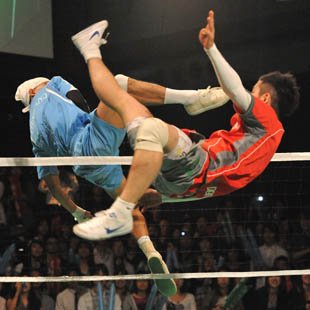
Originally published on metropolis.co.jp on February 2010

Photo by Katsuaki Iwamoto
Sometimes it’s hard to explain the attraction of a sport. Sometimes, too, sportswriters are incredulous that a sport should need explaining. Take short-track speed skating, for example. It’s a high-paced, spectacular—and dangerous—physical contact sport that’s just awesome to watch, yet it gets little to no mainstream exposure. At the same time, we apparently can’t get enough of long-track speed skating—and don’t even get me started on marathons.
As a frequent visitor to Thailand over the years, I’ve seen enough stunning sepak takraw to know that it should be more widely covered. But if you don’t pick up Kansai TV here in Japan, you might never have had a chance to see it for yourself.
For those who don’t know, sepak takraw is a kind of futsal volleyball. Two teams of three players face each other across a 152cm-high net on a badminton court, or one of equivalent size. Each team has an attacker, a server and a tosser (Ed.: insert joke here) and, as in volleyball, the idea is to ground the small rattan ball in the opposite court, or play it off an opponent and out. The tosser sets up the play and the attacker (spiker) delivers the killing blow—usually in the form of a mid-air bicycle kick, which makes for some unbelievable plays.

Photo by Katsuaki Iwamoto
Sepak takraw took root in Japan 20 years ago, helped by the Thai embassy and the Thai Sepak Takraw Federation. A Japan team comprised of university students debuted—along with the sports itself—at the 1990 Asian Games in Beijing, and since then sepak takraw has gradually broadened its appeal. Schools like Asia University, Chiba University and Nihon Physical Education University helped it grow at the college level, and nowadays even Waseda and Keio have their own teams.
Junya Yano, who won a bronze medal in the 2002 Asian Games as a player and then coached the women to bronze in 2006, says people who experience sepak takraw are quickly converted. “It’s not an easy thing to see in Japan,” he tells Metropolis. “But when people see it, they really enjoy it and then they start supporting the national team.”
Major tournaments are now held around the country in places like Hokkaido, Niigata, Osaka and Tokyo, with up to 80 men’s and 50 women’s sides taking part. The Japan Olympic Association lends some support, but players are expected to pay their own way to tournaments, both in Japan and overseas—including the Asian Games and major international events such as the World Championship.
Yano, who has become the face of the sport through regular demonstrations on NHK’s educational channel and in schools around the country, regrets the lack of financial support. “We don’t get money from the JOC because it’s a minor sport; all the money goes to the major sports,” he says.
Rather than sit and wait for the nation to come to its senses, Japan’s sepak takraw scene is finding others ways of drumming up interest. This month, Tokyo residents will get a chance to see some no-holds-barred action at Shibuya O-East, a venue more accustomed to hosting concerts. “Just Fly High, Kelu Vol. 6” is the latest in a series of events fusing music and top-level play. All the participants are national team members, and the games will be more intense, playing to 13 points rather than 21.
A group of DJs and MCs will also be taking part and, if you get hungry, there will be Thai food on sale. However, the main attraction will be the spectacular sport itself. With around 800 people attending the “Kelu” events, which are now into their third year, the word is spreading—sepak takraw is cool.
SEPAK TAKRAW
[kelu] Vol. 6, Just Fly High
Feb 16, 7pm. Shibuya O-East. ¥2,500. Tel: 03-5458-4681.







